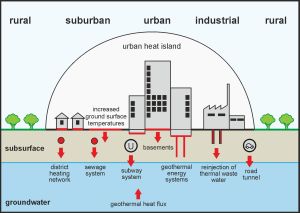Vast energy sources are slumbering below big cities. Sustainable energies for heating in winter and cooling in summer may be extracted from heated groundwater aquifers. Researchers from KIT and ETH Zurich developed an analytical heat flux model and found that increasing heat in the underground is mainly caused by an increase in surface temperatures and heat release from buildings. Work of the scientists is now reported in the renowned journal “Environmental Science and Technology” (DOI: 10.1021/es401546u).
Temperatures in big cities are far above those in the surrounding rural area: Dense settlement, surface sealing, industry, traffic, and lacking vegetation cause an urban microclimate with increased temperatures in the atmosphere. Temperature anomalies also develop in the underground. They spread laterally and vertically. In the past decades, groundwater in conurbations heated up considerably. “In Karlsruhe, the average heat flux density into subsurface aquifers was 759 milliwatts per square meter in 1977. In 2011, a heat flux density of 828 milliwatts per square meter was reached,” says Junior Professor Philipp Blum, Head of the Engineering Geology Division of the KIT Institute of Applied Geosciences (AGW). “This amount of heat corresponds to 1 petajoule per year and would suffice to supply at least 18,000 households in Karlsruhe with heat.“
In cooperation with Kathrin Menberg and Axel Schaffitel from KIT and Dr. Peter Bayer from ETH Zurich, Philipp Blum also studied the origin of heat in the underground of conurbations. The scientists developed an analytical heat flux model to examine factors, such as the increase in temperatures of sealed surfaces, heat release from buildings, sewage ducts, and underground district heating networks as well as discharge of thermal waste water. By modeling anthropogenic heat fluxes into the underground of the city of Karlsruhe, the researchers determined long-term trends of heat flux processes. They found that the increased surface temperature and heat release from buildings in particular are responsible for the increase in temperatures in the subsurface area.
The energy from close-to-surface groundwater aquifers might be used for heating in winter and cooling in summer via geothermal heat pumps and groundwater heat pumps. Use of this geothermal potential would not only cover part of the growing demand for energy, but also reduce the emission of greenhouse gases, which would counteract heating of the cities.
Kathrin Menberg, Philipp Blum, Axel Schaffitel, and Peter Bayer: Long-Term Evolution of Anthropogenic Heat Fluxes into a Subsurface Urban Heat Island. Environmental Science and Technology, 2013, 47 (17), pp 9747–9755. DOI: 10.1021/es401546u.
Karlsruhe Institute of Technology (KIT) is one of Europe’s leading energy research establishments. Research, education, and innovation at KIT foster the energy turnaround and reorganization of the energy system in Germany. For this, KIT links excellent competences in engineering and science with know-how in economics, the humanities, and social science as well as law. The activities of the KIT Energy Center are organized in seven topics: Energy conversion, renewable energies, energy storage and distribution, efficient energy use, fusion technology, nuclear power and safety, and energy systems analysis. Clear priorities lie in the areas of energy efficiency and renewable energies, energy storage technologies and grids, electric mobility, and enhanced international cooperation in research.
Being “The University in the Helmholtz Association”, KIT creates and imparts knowledge for the society and the environment. It is the objective to make significant contributions to the global challenges in the fields of energy, mobility, and information. For this, about 10,000 employees cooperate in a broad range of disciplines in natural sciences, engineering sciences, economics, and the humanities and social sciences. KIT prepares its 22,800 students for responsible tasks in society, industry, and science by offering research-based study programs. Innovation efforts at KIT build a bridge between important scientific findings and their application for the benefit of society, economic prosperity, and the preservation of our natural basis of life. KIT is one of the German universities of excellence.

